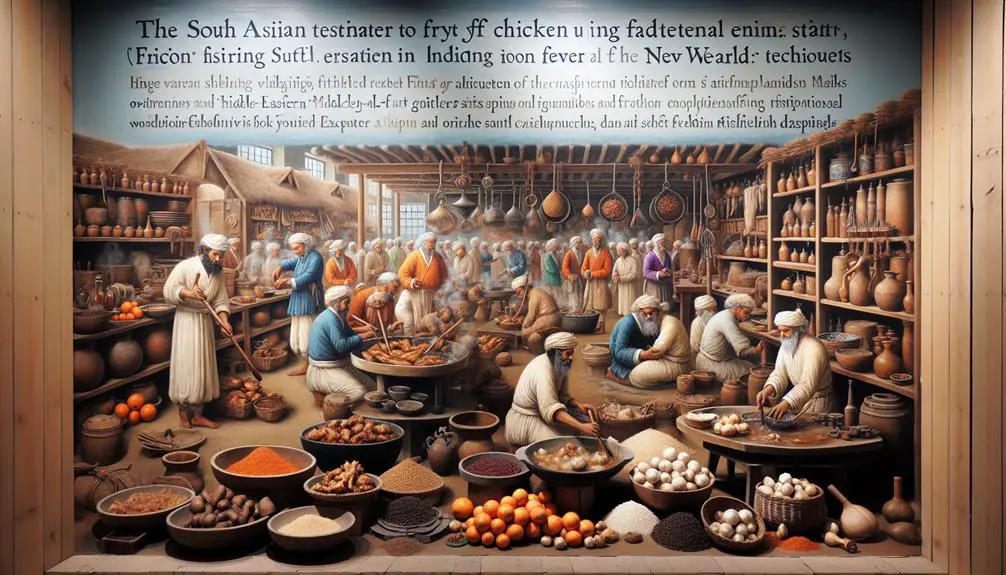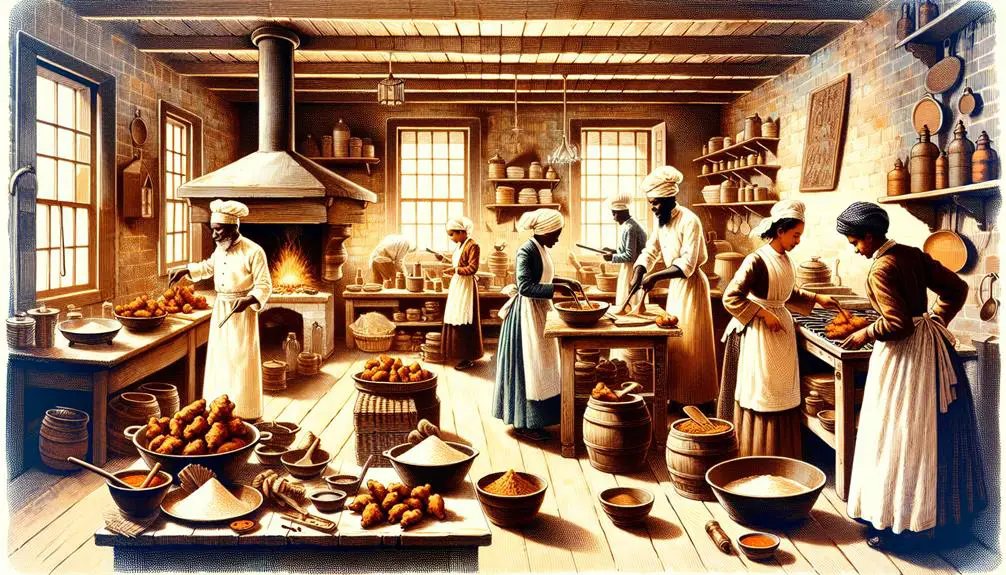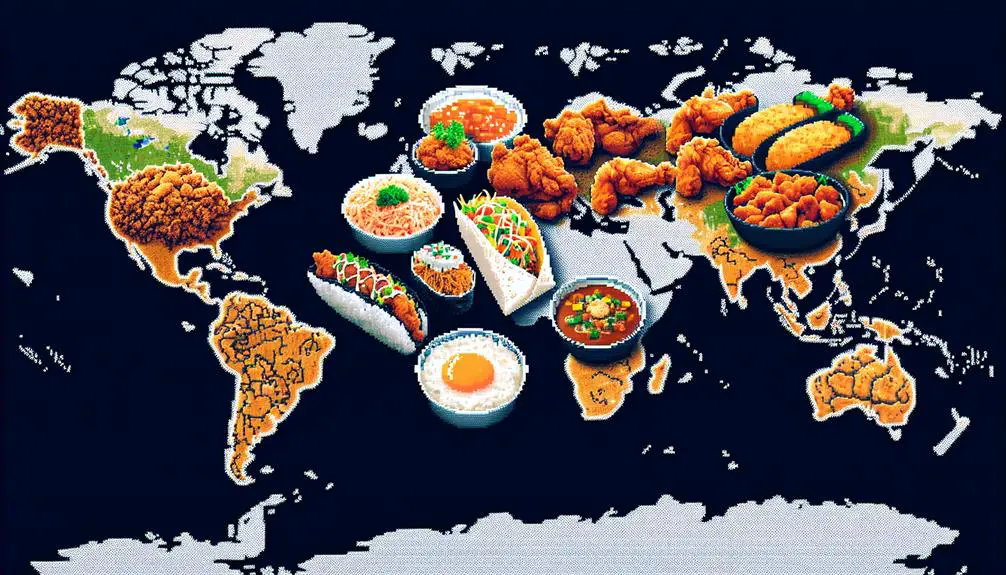When we look at the history of fried chicken, we’re learning about more than just a tasty food. We’re seeing how this dish is a big part of culture, history, and smart cooking.
The story starts with a mix of Scottish frying ways and West African flavors, all brought together in the southern part of the United States by enslaved African-Americans. This food started simple but became famous all over the world.
The story of fried chicken is interesting because it shows how people changed and improved the recipe over time. Now, fried chicken is not just food; it’s a sign of comfort and happiness for many people everywhere.
Let’s find out more about how fried chicken became so important and loved by so many.
Origin of Fried Chicken: Historical Roots

The history of fried chicken goes back to ancient times when people first started frying birds as a way of cooking.
This method wasn’t just about making food; it was considered an art that got better over many years.
Early cooks found out that frying could make even the simplest bird meat taste very good. This was the beginning of what we now enjoy as fried chicken.
As we look into its history, we find that fried chicken has traveled across different continents and cultures.
In the Southern United States, it became very special by combining cooking traditions from Scotland and West Africa.
It’s interesting to see how this dish evolved in America. Enslaved African-Americans, who knew a lot about cooking and seasoning from their heritage, had a big role in making fried chicken popular.
They mixed their ways of seasoning and frying with the Scottish way of deep-frying chicken. This mix created the delicious dish we love today.
Fried chicken became more than just a meal; it turned into a symbol of strength and togetherness, especially among African-American communities during difficult times like segregation.
This dish’s ability to bring people together, along with its great taste, made it an important part of American food history.
Influence of African Cooking Techniques

The history of fried chicken shows how African cooking methods played a big role in shaping this dish in America.
African slaves brought not only ingredients but also their ways of cooking, which had a big impact on Southern cuisine.
One key method was frying in palm oil, making the chicken crispier and tastier.
It’s interesting to see how African frying techniques and American ingredients came together perfectly.
Corn, which is from the Americas, became an important part of fried chicken’s coating, giving it a special texture and taste.
African spices like cayenne pepper mixed with local seasonings, leading to the deep, rich flavors we associate with Southern fried chicken today.
Making fried chicken, which was once a special occasion dish among African slaves, turned into a common practice in the American South.
This shows more than just the mixing of cooking styles; it highlights the strength and creativity of African slaves.
They adapted their traditional cooking to use what was available in America, creating a dish that has had a big influence on American food culture.
Emergence of Fried Chicken in the United States

Fried chicken became popular in the Southern United States, thanks to the cooking skills and traditions of enslaved African-Americans.
They introduced frying techniques and new spices to the dish. This change was more than just about food; it showed their ability to create and adapt under very difficult conditions.
Enslaved people made fried chicken for special occasions in African-American communities, especially when they’d limited resources during segregation.
This practice continued, making fried chicken a common dish for family events and community gatherings.
The dish represents the history, survival, and resistance of those who first made it popular.
Later, fried chicken came to be seen as a symbol of Southern hospitality and comfort food.
People like Colonel Sanders and Austin Leslie helped make fried chicken popular worldwide. But it’s important to remember the origins of the dish and the people who first made it.
Now, when you eat fried chicken, it’s not just food. It represents a culture, passed down through generations, and stands for community and resilience.
Fried chicken tells a story of survival, innovation, and identity in American history.
Key Ingredients and Seasonings

Learning about the history and importance of fried chicken helps us appreciate how it’s made, especially the choice of chicken and the special mix of seasonings and breading that makes each recipe stand out.
When picking your chicken, look for fresh and high-quality. Young chickens are usually softer and tastier, perfect for frying.
Recipes often suggest cutting the chicken into pieces to cook evenly and get the right balance of crispy outside to meat inside.
Marinating or brining the chicken is a common step, adding flavor and making the meat tender.
Buttermilk is a favorite for this because it adds a light sour taste and the acidity makes the chicken tender.
The breading is an important part. You coat the chicken with a mix of flour, cornstarch, or breadcrumbs mixed with a special blend of spices.
This special blend is what makes each recipe different. Traditional Southern recipes often use garlic powder, onion powder, salt, pepper, and paprika.
But trying new spices like cayenne for spiciness or a little sugar for sweetness is also good.
The way you cook it’s also key. You can deep-fry, pan-fry, or use an air fryer, aiming for a crunchy outside and moist inside.
The oil’s temperature is very important – if it’s too hot, the outside will burn before the inside is done, and if it’s too cool, the chicken will soak up too much oil and be oily.
Cooking Techniques

Exploring cooking techniques reveals how deep-frying and pan-frying have significantly influenced the preparation and enjoyment of fried chicken.
These methods affect the food’s texture and flavor and have evolved due to advancements in cooking equipment and practices.
Deep-frying chicken involves immersing it in hot oil. This method quickly seals the exterior, creating a crispy layer while keeping the inside moist.
It’s important to keep the oil at the right temperature. If the oil is too hot, the outside may burn before the inside is fully cooked.
If it’s too cool, the chicken might absorb too much oil and become greasy.
In contrast, pan-frying uses less oil and involves cooking the chicken in a shallow pan. This method requires careful timing to flip the chicken pieces at the right moment.
This ensures an even cook without burning the crust. Pan-frying requires close attention but results in a crunchy texture with less oil.
Advancements in kitchen technology have improved these frying methods. Modern deep fryers with temperature controls help maintain ideal frying temperatures, making the process easier and safer.
Non-stick pans and induction cooktops have made pan-frying more efficient and consistent.
Additionally, the use of healthier cooking oils and the introduction of air fryers provide alternatives that aim to recreate the taste and texture of fried chicken with fewer calories.
These innovations show a movement towards combining tradition with healthier eating habits, securing fried chicken’s place in future meals.
Cultural Significance

Exploring the effects of deep-frying and pan-frying on fried chicken’s texture and taste, we shift our focus to its cultural importance, including its symbolic meaning in events and how its preparation varies by region for different occasions.
Fried chicken isn’t just food; it’s an important cultural element in many celebrations and traditions globally.
In the Southern United States, fried chicken symbolizes family and community. It’s often the main dish at gatherings and picnics, representing the warmth of sharing meals together.
During Juneteenth and similar historic events, it signifies resilience and happiness in African-American communities.
In Japan, a unique tradition exists where people eat KFC fried chicken to celebrate Christmas. This shows how widely fried chicken is recognized and how it can fit into different cultures worldwide.
In Korea, Korean fried chicken, known for being double-fried, is popular at social events and celebrations. Its crunchy outside and juicy inside, often covered in a sweet and spicy sauce, is a party favorite.
These examples show that fried chicken plays various roles, reflecting local tastes and traditions.
From the spicy Nashville hot chicken to the citrusy Guatemalan fried chicken, these regional versions show how fried chicken is a symbol of joy, community, and cultural identity across the world.
Evolution of Fried Chicken

Fried chicken has changed a lot over time. It started as a simple dish in Southern kitchens and has become popular worldwide. Chefs and home cooks keep finding new ways to make it.
Originally, fried chicken was known for its crispy outside and juicy inside.
This was achieved by marinating the chicken in buttermilk or spices, then coating it in flour and frying it. Now, there are many new and exciting ways to make fried chicken.
Chefs around the world are using different ingredients and methods to add new flavors to fried chicken.
For example, Korean fried chicken is very crunchy and coated with a sweet and spicy sauce. Japanese Karaage uses a ginger-soy marinade and potato starch for a lighter version.
In places like Nashville, fried chicken is made spicy with a cayenne-infused oil. There are also dishes that combine fried chicken with waffles, mixing savory and sweet flavors.
Every new version of fried chicken shows how this dish is constantly evolving. It reflects the creativity and diversity of cooks everywhere.
Notable Recipes

Let’s explore famous fried chicken recipes from around the world. We’ll cover ingredients, how to measure them, and give you step-by-step frying directions.
You’ll learn how to make different and unique fried chicken dishes, including gourmet versions.
First, we talk about classic Southern fried chicken. You need 3 lbs of chicken pieces, 1 cup of buttermilk, 2 cups of all-purpose flour, and spices like salt, black pepper, paprika, and garlic powder.
Marinate the chicken in buttermilk overnight. Mix spices with flour, coat each chicken piece, and fry in oil at 375°F until it’s golden brown.
Next, let’s look at Japan’s Tatsuta-age. Instead of buttermilk, marinate chicken in soy sauce, sake, ginger, and garlic.
Coat with potato starch and fry until crispy. This gives a crunchy texture and rich flavor.
For a spicy version, try Nashville hot chicken. Fry Southern-style chicken, then brush with a mix of cayenne pepper, brown sugar, paprika, garlic powder, and some frying oil.
This makes it sweet, spicy, and full of flavor.
Gourmet versions of fried chicken use fancy ingredients like truffle oil in the marinade or serve the chicken on a waffle made with Belgian flour, topped with real maple syrup and edible gold dust for a luxurious dish.
These recipes show how versatile and popular fried chicken is, offering a chance to try different flavors and techniques from around the world.
Global Recognition and Influence

Fried chicken has become popular worldwide, showing how different cultures have adopted and adapted it into their own cuisines, showing a shared love for this crispy food.
Originally from the Southern United States, fried chicken has spread globally, taking on new forms and flavors in various countries.
In Japan, people enjoy Karaage, which is chicken cut into small pieces, marinated, and then fried, usually served with lemon.
This version of fried chicken shows how it has been integrated into Japanese food culture. In Korea, the chicken is fried twice to make it very crispy on the outside while keeping it juicy inside.
It’s often covered in different tasty sauces, such as sweet soy garlic or very spicy ones. This Korean version has become popular worldwide, illustrating how fried chicken can be adapted in different ways.
In Europe, chefs are mixing fried chicken with local tastes and ingredients, creating new and unique dishes.
For example, in Italy, you might find fried chicken on top of pizzas, and in Spain, there could be spicy chicken tapas. These examples show that fried chicken isn’t limited by geography.
The worldwide popularity of fried chicken highlights its broad appeal and ability to be customized.
It’s loved for its crispy texture, juicy meat, and the many ways it can be reinvented. When you eat fried chicken, you’re participating in a global community of people who enjoy this comforting and delicious food.
Wrapping Up
As you learn about fried chicken, you discover it has a long history and is very important in many cultures. People have been frying chicken in different ways for a long time, and now there are many new and fancy ways to make it.
Every time you eat fried chicken, you’re sharing something special that many people worked hard to make perfect. So, when you enjoy its crunchy and tasty flavor, think about the stories and traditions it brings with it.
Fried chicken is more than just a meal; it’s a story about people coming together and creating something amazing.
